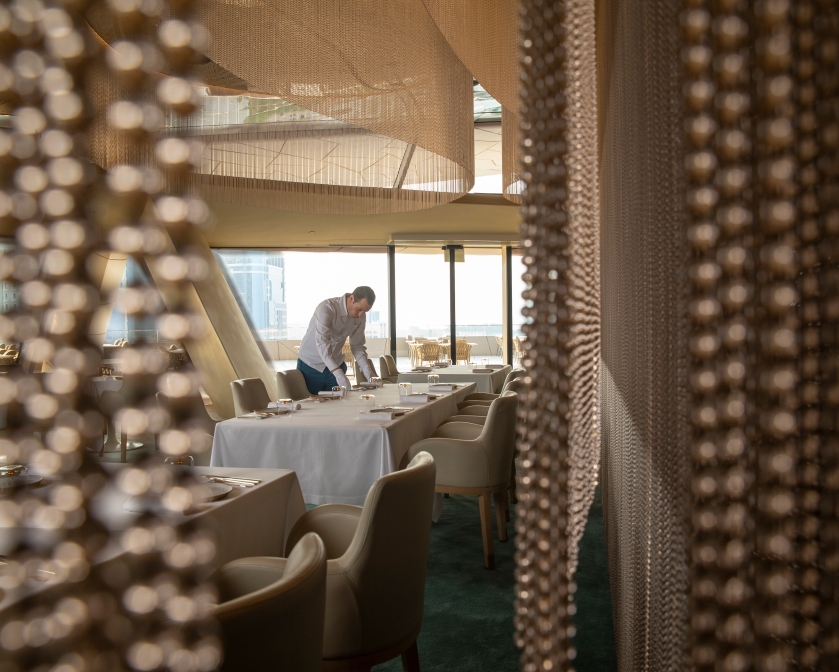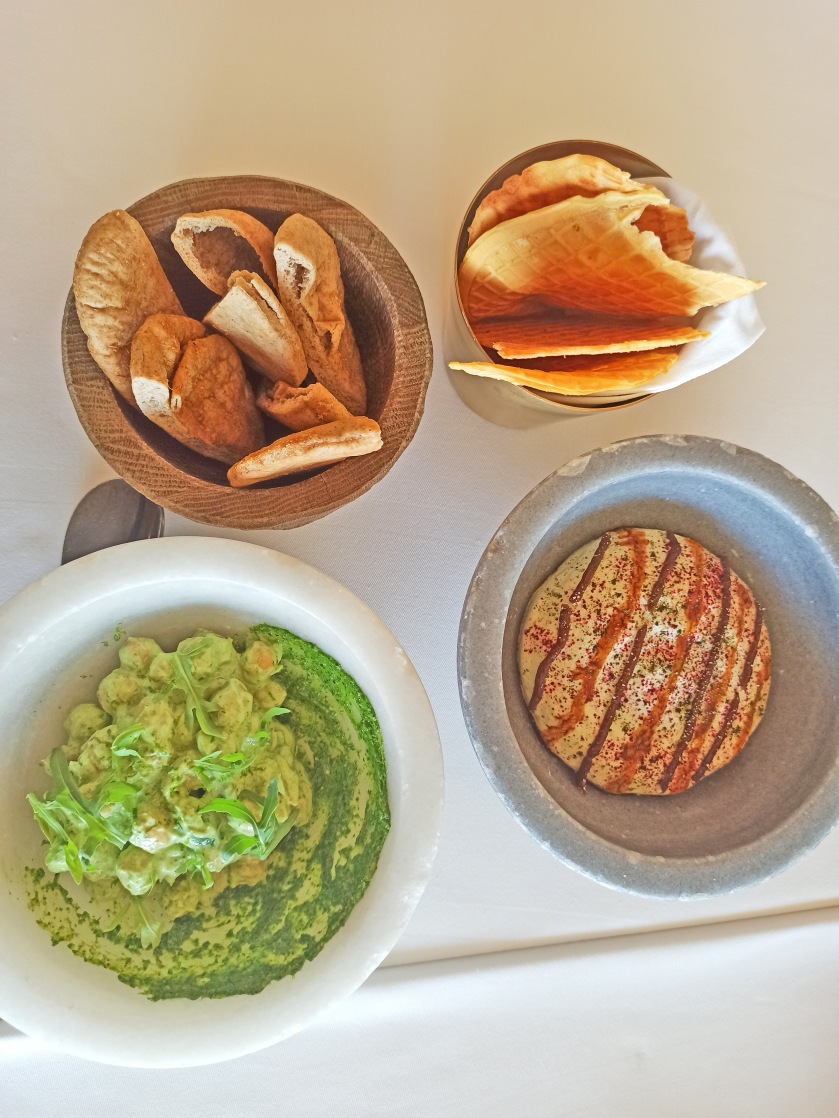While on a last-minute daylong layover in Doha, Qatar, I was invited by In-Q Enterprises to write a restaurant review over breakfast at one of their premier clients, Jiwan.
Located inside the avant-garde National Museum of Qatar complex, with sweeping views of the Doha skyline and the Arabian Sea, Jiwan can seat more than 200 guests, both inside, and on the beautiful terrace. It opened in December 2019, and has been a popular spot on Doha’s culinary scene ever since.

Jiwan, which specializes in showcasing Qatari and other Middle Eastern dishes with a contemporary flair, comes from the Arabic word for perfect pearl. Before dry natural gas and petroleum were discovered, Qatar was a world leader in pearl diving; a “perfect pearl” is one that has a rose-tinted white color, with mirror-like radiance.
Furthermore, Jiwan is part of the Alain Ducasse family of restaurants. Hailing from France, Alain Ducasse was the first ever chef to have three different 3-Michelin star restaurants under his belt; in addition to France and Qatar, his company has restaurants and chocolateries throughout the world, including in the United States, Japan, Thailand, and Singapore.
Although those outposts generally focus on French specialties, Jiwan takes a markedly different approach. The idea behind Jiwan is to take Qatari and other Middle Eastern favorites, give them a contemporary spin, and present many of them to be shared at your table.

After reading that paragraph, I presume a number of us have one question mind: what is Qatari food?
The easy answer: let’s continue below.
Another answer: rice and grilled or boiled meat play a big role in Qatari cuisine.
However, if you’re more into learning about what the condiments and spices are like, then I’ve got you covered.
You see, with Qatar’s history along major seafaring trade routes between three continents, dried limes (loomi), ginger, cumin, cinnamon, and cardamom, and cloves play a big role in adding extra flavor to dishes such as:
– majboos, arguably the Qatari national dish, it contains slow-cooked meat with rice and some of the above-mentioned spices. Tomatoes and onions might also be present.
and
– harees, a rice and lentil porridge with meat.
But those are just a couple of the most popular examples of Qatari meals, albeit not typically served for breakfast. It would be fair to say that my breakfast at Jiwan turned into an early lunch, due to the affable nature of Executive Chef Morgan Perrigaud.
Executive Chef Perrigaud hails from the Brittany region of France, and possesses a distinguished background from having worked at Michelin-starred kitchens in France, Spain, and the United Kingdom. He’s a very down-to-earth person, eager to take on the challenge of trying to prepare modern takes on regional dishes for an extremely diverse clientele.

Soon after being seated, I was served a detox beetroot shake, Qatari coffee with dates on the side, and a bottle of still water. It’s important to note that every employee was attentive, with all exemplifying the Japanese concept of omotenashi, in other words providing good hospitality without being overbearing.
And then the first plates arrived.

Starting from the left, we have eggplant regag. Regag is a baked flatbread made with wheat, salt, and water, and baked until slightly crispy. These regag were stuffed with eggplant, and were quite fun to eat. They were especially good the majboos-spiced eggs, and kale shakshuka, or soft-cooked eggs ordinarily prepared with tomato sauce. The regag and shaksuka was an especially memorable flavor combo; it was surprising to see kale make an appearance on a menu specializing in Gulf cuisines, but that’s all part of how Chef Perrigaud has been contemporizing the dishes.
The one item that seemed way out of place on an otherwise delicious breakfast menu was called balaleet. Although it’s certainly from the region — either from Iran, or one of the Arabian Gulf countries — as a postscript, I’m glad I was never offered it before. Basically, it is rice vermicelli sweetened with sugar, cardamom, and rose water, and served with strips of eggs; other recipes call for onions and potatoes, but Jiwan stopped short of adding those two things to this bizarre creation.
Although this was only “round 1,” I needed get up and move around a bit. At this point, one of the managers approached me to describe how much detail went into the design of Jiwan. For example, the carpet is colored different hues of blue, to reflect the Arabian Sea. Also, given that the name of the restaurant means “perfect pearl,” there are countless Swarovski glass “pearls” suspended from the ceiling.

And the terrace wasn’t too shabby either.


Too hot! I retreated back to my table for the next tasty round.

Two simple sounding plates with two exceedingly divergent flavors. And both were excellent.
On the left, a garlicky mash of tahini, yogurt, and chickpeas, something I would absolutely eat everyday, either with a toasted carb of some sort, or with crudités. Its companion to the right is labneh, strained yogurt, a Middle Eastern classic, but in this case made with mint and tamarind, and whipped to the point of being foamy. Coincidentally, there were some tamarind trees right outside of the National Museum of Qatar, which makes me wonder where in the country Jiwan sources many of its ingredients.

I asked for olive oil and flatbread to enjoy with the yogurt, and got a bonus of the chef’s blend of baharat, or spices.
Now, at this point, there was another short break between courses. I had sampled the breakfast menu, and was now being offered other dishes to try.

Ginger saffron rice. I was already quite satisfied with the carbs by this point, but I have to admit, the strong ginger and subtle saffron flavors made this unexpected dish a hit.
As I was enjoying rice, Chef Perrigaud mentioned something about charred octopus. Being a huge fan of seafood, I was curious to know if I could get in on the Cephalopod action.
Indeed I could.

What a flavor and texture trip.Grilled just enough for the right crisp, while still retaining both the flavor of octopus, and a slight chewiness.
Upon my request, the nice Sri Lankan chefs whipped up a chili pepper sauce to accompany the expertly grilled octopus.
If I didn’t have to worry about cholesterol, I’d eat this everyday, too.
Following a brief third respite from eating, it was time for dessert. Now, whereas I was quite satisfied with most of the courses up until this point, dessert was something of a letdown.

Clockwise from the top left, hazelnut cake, pistachio and labneh crepe, and pineapple with mint in a saffron and pomegranate juice.
In this case, I’d have to give the top spot to the dessert least affected by the hands of a chef, that is the pineapple. I’ve tended to consider saffron as a very strong flavor, but again, just like with the ginger rice, it took a backseat to the freshness of the tropical pineapple, and the earthy mint.
As for other two plates, the hazelnut cake was sorely lacking in flavor, and the crepe was barely sweet. That weird balaleet served at breakfast was much more befitting of a typical dessert than these two things.
I was hoping for something more local, perhaps luqaimat, fried dough balls topped with date syrup and sesame seeds, but you can’t win ’em all.
In spite of the subpar dessert, I had a quality time at Jiwan. The service was on point, Chef Perrigaud seemed like a genuine fellow having a good time creating the restaurant’s menu, and the rest of the food was a nice blend of local and international flavors. The clean appearance of the interior and terrace, unique location at the National Museum of Qatar, and welcoming atmosphere further sealed the deal.
If you happen to be in Doha, I’d recommend a breakfast or lunch at Jiwan.


One thought on “Restaurant Review: Jiwan in Doha, Qatar”